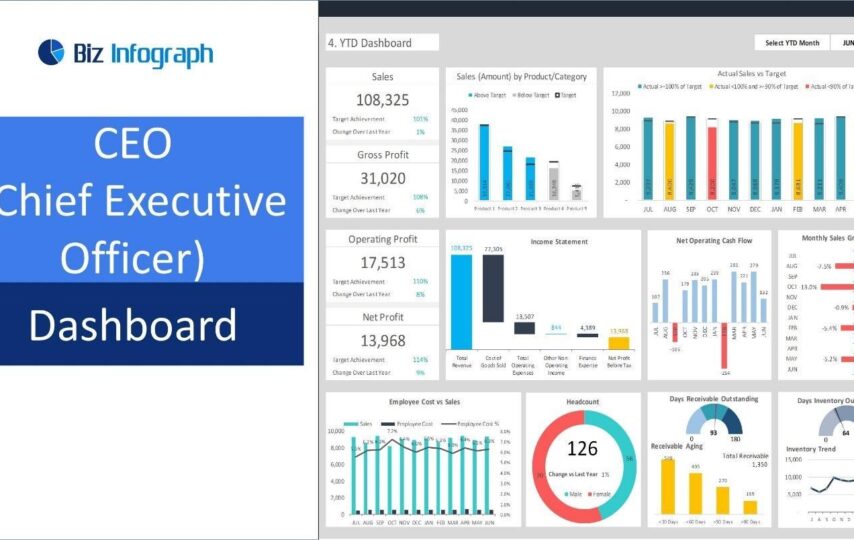Introduction
The simplicity of the business insight in CEO dashboards favours rational, precise, and progressive decision-making during critical events. By engaging with a plethora of real-time data-driven information and arming your top management officials with the means of generating meaningful stories with the help of CEO reports, you will make consistently potent business decisions that will inarguably aid the expansion of your enterprise. Discover essential CEO dashboard features for effective strategic decision-making and leadership.
Organizations use dashboards in their communication because it is easy to determine the performance of each department and the organization at large. The more time a CEO spends getting such information from various sources, including spreadsheets, website analytics reports, and other report forms, the more inaccurate the information and insights accumulated need to be more accurate, thus wasting time and effort. A CEO dashboard consolidates all the data you need to present in a single information product so that all the information on the performance of the business is presented on a single panel.
Key performance indicators(KPIs)
Financial metrics
Gross sales, net income, operating margins, and cash flows for various corporations are financial performance measures relevant to evaluating a company’s financial position. Revenue captures total sales proceeds in a period, a core economic activity in any firm.
Gross profit margins enable the identification of the efficiency in turning total sales revenues into gross profit. They are summarized as the movement of funds within accounts or necessary for operations and investments of an organization. In total, all the above-mentioned measures can contribute to the identification of the effectiveness of the work of the Company, the revenues and the ability to manage financial assets, which is useful in the assessment of the performance of a business and making the right decisions about investments, development and sustainability.
Operational metrics
Business operation indicators or variables include production performance, customer satisfaction ratio, and supply chain as far as evaluating the performance and efficiency of a firm are concerned. It measures output of the assets used, showing productivity and cost-effectiveness. Customer service determines customers’ satisfaction and loyalty, which helps retain them and strengthen the brand image. Supply chain measures reflect the effectiveness of activities in managing the flow of materials, products, services, inventory, and suppliers, which are instrumental in cost efficiency and reliability. All these KPIs enable organizations to view how effectively their operations are running, how customers’ expectations are being managed, and how supply chains are being managed well, and hence, performance and profitability improved.
Human Resources metrics
Measures relating to employees’ productivity and satisfaction levels, including attrition rates, are essential to evaluating the vitality of an organization. Voluntary turnover rates calculate how often employees leave the organization, how much it costs, and issues affecting succession. Engagement scores check the workers’ attitude and willingness, which are vital to the output and tenure of employees. These metrics assist HR departments and managers in evaluating the tendencies within many aspects of the work environment, organizational culture, and management practices. In this way, organizations improve the efficiency and effectiveness, creative approach, and motivation of employees, which become critical factors in the continuation of stable organic growth and the creation of competitive advantages in the market.
Real-time data access
Benefits of real-time data
Real-time data makes sure that organizations have the latest information about the market situation and customers and organizational outcome. Through the research carried out, technological developments, especially in the use of ICT, leaves organizations in good stead to obtain real time information and forward this information to take advantage of such information and equally, ward off any likely risks. It increases competitiveness and the organization’s operation since information results from current rather than old data. Real-time also allows companies to implement proactive measures in fast-changing conditions needed to achieve strategic goals in various markets and to obtain the best results optimally using resources.
Implementing real-time data systems
Real-time data integration involves using robust technologies such as data integration platforms, scalability through cloud computing, and databases that enable a fast query. The application of stream processing tools like Apache Kafka or Apache Flink also deals with stream data, guaranteeing data updates in real time. There are fundamental time visualization tools like Tableau or Power BI that design easy-to-use dashboards for everyday applications. Also, implementing APIs and automated alerts guarantees that stakeholders are informed quickly. These components allow a business to track KPIs, flag issues, and make the right decisions implicitly fast.
Data visualization tools
Graphs and charts
For quantitative data, bar charts and line graphs display the trend of the data, cyclical spacing, or by different categories. Pie charts can be used to show relations within a whole being in the form of proportion or percent. Scatter plots are most appropriate for portraying relations and correlations between variables. Heat maps describe how data are distributed and are particularly effective if the data is dense or sparse. The proper selection of visualization data depends on the data type and the message that has to be delivered, including the possibility of misunderstanding the data of the decision-maker.
Interactive elements
Drill-downs and sliders are some of the interactivity features that increase users’ engagement through filtering subsets and parameters of data. Drill-downs allow further exploration of different data levels, which helps carry out elaborate data analysis and decision-making processes. This is mainly done through sliders, which allow for the manipulation of variables for dynamic control and experimentation. These features enable users to customize the visualization to get the correct result within a short span of data analysis, including trends, outliers, correlation, etc., and appropriately enhance decision-making and strategic planning.
Customization and scalability
Tailoring dashboards to CEO needs
When designing the executive dashboards, it is vital to pay much attention to the goals and objectives that are significant for the company’s chief executive officers, like financial and market outcomes and organizational efficiency. Position quantitative values such as revenue increase, Gross/Net margins, and Cost of Sales/Customer Acquisition Cost conspicuously. It is advisable to use graphics that paint clear comparisons, trends, and forecasts based on the CEO’s preference. Include links and buttons that allow for further analysis of key data and make the data dashboard available across multiple platforms essential for real-time business decisions.
Ensuring scalability
For this reason, robust data integration and visualization components that will enable the dashboard to grow in size when handling a large volume of information should be adopted. Construct a sound structure for various data types and modern analytic demands. Make changes to application dashboards that suit the organization’s requirements, as suggested by the users, and periodically evaluate the business requirements. Projects’ scalability must be considered suitable from the planning stage so that the applications can quickly scale up to remain dependable.
Integration with other platforms
CRM and ERP systems
One benefit of integrating with CRM and ERP is consolidating information on critical business indicators on dashboard. This integration enriches decision-making by combining information gathered from the customers through CRM with operational data gathered through ERP. This guarantees that all line departments of an organization, such as sales, marketing, finance, and operations, are in harmony in their quest to evaluate performance trends and standards, customer responses, and the financial status of organizations. This integrated organizational perspective promotes decision-making for strategic management, resource allocation, and process management at the managerial level.
External data sources
Integrate third-party data feeds through APIs, connectors, and integration tools to improve understanding of the market. Use information from market research agencies, currently available reports, social media analysis, and economic factors. Apply data blending methodologies that allow the integration of internal and external data; this would help manage the business and react quickly to market changes and competitors’ actions.
Security and accessibility
Ensuring data security
Data protection displayed on dashboards can be more efficient. Therefore, additional measures should be taken, like data transfer and storage encryption. Implement RBAC mechanisms to restrict access to the dashboard depending on the employee’s position. Make sure to put into practice current security updates and use a firewall to shut down possible threats. It has been recommended to perform routine checks and analysis of the access logs for any intrusion and act accordingly. In that regard, it is essential to inform users about measures to avoid threats originating from leakage of sensitive data.
Mobile access
Making certain that critical data can be accessed through smartphone and/or tablet-compliant dashboards also helps in availing information at all times. It also enables decision-makers to track performance as it happens, alter it, and ascertain critical business parameters in real-time. It improves the speed of decision-making, which is vital for the efficiency of operations and competitive advantage.
Conclusion
Financial performance, market share, and operations are a crucial part of Biz Infograph CEO dashboard. The numbers should be presented in a way that allows for further exploration with the help of additional links/expanders. It should compile data from the customer relations management and the enterprise resource planning software for comprehensive departmental synchronization.
Acquiring an extensive and personalized dashboard improves the organization’s strategic management since it allows users to access necessary data on various gadgets simultaneously. This enables CEOs to have a clear view of the key performance indicators, investigate trends, and make strategic actions concerning opportunities and threats, thus increasing the organization’s performance and survival in a competitive environment.








